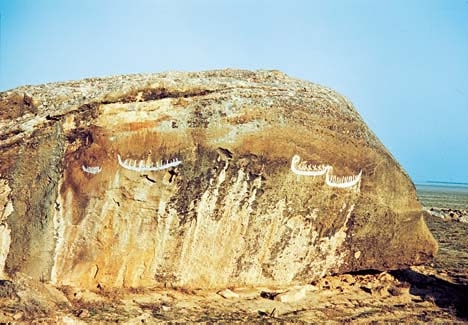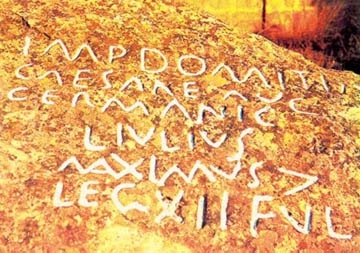According to Thor Heyerdahlthe Norwegian mythology tells that the Scandinavian god Odin moved with his people to Norway from a land called Aser, in order to avoid Roman occupation. A 13th-century historian's description of Aser's origination matches that of Azerbaijan: east of the Caucasus mountains and the Black Sea.
Heyerdahl and other scholar are convinced that people living in the area now known as Azerbaijan settled in Scandinavia around 100 AD. Roman troops arrived in Azerbaijan in 97 AD.
Odin came from the land of the "Aser" (Aeser), and is, therefore, frequently referred to as "Asa-Odin" (Aser-Odin).
Asgard or Ásegard is the realm of the Gods Aser in Norse religion and Norse mythology. The exact meaning of "Asgard is Aser Land or the Land of Aser". Modern day Scandinavians migrated north from the east of the Caucasus, Aserbaijan (Azerbaijan/Caucasian Albania) in prehistoric times. According to Icelandic Sagas, written in the 13th century, the Norse God Odin migrated from the east of the Caucasus, from Aserbaijan in the first century AD.
Heyerdahl concluded that Azerbaijan and not northern Europe was the center from which the Caucasian people spread so that Chinese archaeologists would find their 4000 years old remains buried in northwestern China. He based that conclusion on early Norwegian sagas written down by the Icelander, Snorre Sturlason, before his death in 1241, (Snorri, The Sagas of the Viking Kings of Norway. English translation: J. M. Stenersens Forlag, Oslo 1987).
By Thor Heyerdahl
Early Scandinavian History
We learn of the line of royal families in Denmark, Sweden and Norway. But we didn't take these stories about our beginnings seriously because they were so ancient. We thought it was just imagination, just mythology. The actual years for the lineage of historic kings began around the year 800 AD. So we learned all the kings in the 1,000 years that followed and did not interest ourselves in earlier names.
But I remember from my childhood that the mythology started with the god named Odin. From Odin it took 31 generations to reach the first historic king. The record of Odin says that he came to Northern Europe from the land of Aser. I started reading these pages again and saw that this was not mythology at all, but actual history and geography.
Snorre, who recorded these stories, started by describing Europe, Asia and Africa, all with their correct names, Gibraltar and the Mediterranean Sea with their old Norse names, the Black Sea with the names we use today again, and the river Don with its old Greek name, Tanais. So, I realized that this has nothing to do with the gods who lived with the Thunder god Thor among the clouds.
Snorre said that the homeland of the Asers was east of the Black Sea. He said this was the land that chief Odin had, a big country. He gave the exact description: it was east of the Black Sea, south of a large mountain range on the border between Europe and Asia, and extended southward towards the land of the Turks. This had nothing to do with mythology, it was on this planet, on Earth.
Then came the most significant point. Snorre says: "At that time when Odin lived, the Romans were conquering far and wide in the region. When Odin learned that they were coming towards the land of Asers, he decided that it was best for him to take his priests, chiefs and some of his people and move to the Northern part of Europe."
The Romans are human beings, they are from this planet, they are not mythical figures. Then I remember that when I came to Gobustan, I had seen a stone slab with Roman inscriptions. I contacted the Academy of Sciences of Azerbaijan. I was taken to the place, and I got the exact wording of the inscription.
There's a very logical way of figuring out when this was written. It had to be written after the year 84 AD and before the year 97 AD. If this inscription matched Snorre's record, it would mean that Odin left for Scandinavia during the second half of the 1st century AD. Then I counted the members of the generations of kings, every king up to the grandfather of the king that united Norway into one kingdom, because such information is available - around 830 AD.
In anthropology we reckon 25 years per generation for ruling kings. In modern times, a generation may extend up to 30 years, but on average the length of a generation in early reigns is 25 years. When you multiply 31 generations by 25 years, you come exactly back to the second half of the 1st century AD. So there is proof that these inscriptions carved by the Romans in stone coincide with the written history written almost 1,800 years ago in Iceland.
We all know that the Northern people are called Caucasian. Here is where history, archeology, geography and physical anthropology come together.
The more I research the topic, the more evidence I find that this part of the planet has played a much more significant role than anybody ever suspected. I am working on a book at present together with a colleague, and we are halfway through it describing our observations.
Blond-Haired Mummies
In the meantime we have contacts with the Academies of Sciences in 11 nations. We do not want to leave anything out. The most surprising discovery was when we contacted Communist China. They had discovered blond-haired mummies in the Karim Desert deep inside China, so perfectly preserved in the cold climate and salty earth that you could see the color of the skin and hair. The Chinese archeologists were surprised because these mummies were not Mongoloids at all; they suspected instead that they were Vikings.
But it didn't make sense to me that Vikings should be deep inside the deserts of China. When the Chinese archeologists conducted radio-carbon dating, they determined that the mummies were of Nordic type dating from 1,800 to 1,500 years BC. But the Viking period started around 800 AD. It then became obvious that these mummies were not Vikings who had come to China. Here was a missing link. And again the Caucasus enters into the picture as a mutual migratory center.
But this is not the end of the story. These mummies were dressed in cloth that had been woven, and the colors and the woven pattern were of a very specific type. The Chinese themselves studied the mummies and then invited American experts to study the clothing who determined that the weave and coloring were typical of the Celts of Ireland. But this made no sense at all. Then we contacted Ireland to get their sagas, and their written saga says that their ancestors were Scythians. So, again, their roots come back here to the Caucasus.
This is only the beginning, because this is as far as we have obtained documentation from the Academies of Sciences with which we are in contact. I will not go into detail further, but I have also found archeological evidence that is so striking that there can no longer be any doubt.
My conclusion is that Azerbaijan has been a very important center, sending people in many directions and attracting people from many directions. You have had metals that made the Romans want to come here. But you have been very central in the evolution of civilization, and more than anything, this is proven by the petroglyphs in Gobustan.
One thing is clear: navigation occurred before civilization. We used to believe that civilization came first, and once people had developed a high enough level of civilization, then they started to build boats. This just isn't true. On the contrary, it was when people built ocean-going vessels - that enabled them to contact each other so that they could trade and learn from each other. It was through contact and peaceful cooperation that civilization developed.

Above: In the ancient caves of Gobustan which date back at least 5,000 years, cave drawings depict two different kinds of boats that were used for early navigation. Heyerdahl is convinced that people living in the area now known as Azerbaijan settled in Scandinavia around 100 AD. Gobustan is located about 30 miles southwest of Baku.

Above: Roman inscription at Gobustan indicating that Roman troops were in the region around 97 AD.
